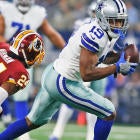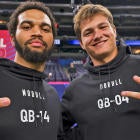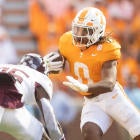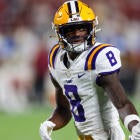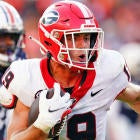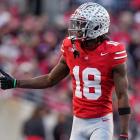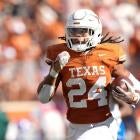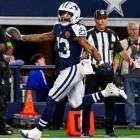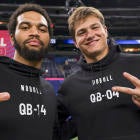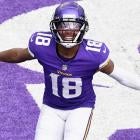With the 2019 regular season in the books, I'll be going division by division to share my initial offseason takeaways from each team.
This is mostly postseason note-taking as I emphasize what stands out most from the Stealing Signals column in 2019. We have an entire offseason of coaching and personnel changes plus additional research to break down what our 2020 Fantasy expectations will be, but I intend to refer back to these pieces as a barometer of sorts.
Dallas Cowboys
Snap Notes: Concentrated with primary five players in 11 personnel — Ezekiel Elliott, Amari Cooper, Michael Gallup, Randall Cobb, Jason Witten — all typically playing big snaps when healthy
Key Stat: Dak Prescott — 9.4 yards average throw depth, 5,454 air yards (previous career highs: 8.3, 4,118)
Dak Prescott became a downfield passer in Kellen Moore's system in 2019, and the offense reaped benefits across the board. While detractors can argue they tallied garbage time production in some losses and feasted on weaker opponents on their schedule, the final tally is astounding — their 6,904 yards from scrimmage led the league by 383, outpaced the 2018 Chiefs and were the most in the NFL since Peyton Manning's 2013 Broncos.
Detractors could also argue that didn't matter, as they missed the playoffs. And it's fair to point out they scored only the sixth-most points in the league despite all those yards. Still, their plus-113 point differential was third best in the NFC, 82 points clear of the division-winning Eagles, and it's pretty clear situational coaching and good ol' luck played a role in their underwhelming W-L record.
The concern for Dak Prescott and the passing game will be whether a new coaching staff impacts that passing philosophy. Dak finished QB3 despite a career-low 277 rushing yards and just three rushing touchdowns after six in each of his first three seasons. That's still solid production to chip in with his legs, and now that we know he has this type of passing upside, he's a solid QB1 in 2020 drafts.
Ezekiel Elliott got paid and his holdout didn't impact his production much. He rushed over 300 times for the third time in his four-year career — in that span, the rest of the league's running backs have totaled just two 300-carry seasons (2019 Derrick Henry, 2017 Le'Veon Bell). The downfield passing did mean Zeke's receptions dipped from a career-high 77 in 2018 to 54 in 2019, but he still provides value in the passing game. If there's something in his profile to be concerned about, it's the sheer number of touches he's amassed in his four-season career; he leads the NFL with 1,358 since 2016, and only Todd Gurley is within 290 touches of that number.
Amari Cooper is a free agent, but it seems likely Dallas will try to bring him back. I don't put a ton of weight on home/road splits, but Cooper's were massive in 2019 (21.2 PPR points per game at home, 9.6 on the road), and it was a significant factor in Dak displaying big home/road splits as well. Amari was great in Dallas at the tail end of 2018 as well, and it's notable that Dallas is a mostly weather-controlled stadium with turf, and we've seen other big home/road splits from teams that play home games in domes, like New Orleans.
Michael Gallup took a big step forward in Year 2, and finished with just six fewer targets and 82 fewer yards than Amari in two fewer games. Cooper did leave a game very early — a 4% snap share against the Jets — so that gap is more like one game's worth of playing time.
But Gallup had a strong prospect profile and looks like he's both a clear hit at the NFL level, and still likely to be underrated. A psychological bias known as the primacy effect forces us to apply too much weight to what we see early in a season, and Gallup missed time in September. Then there was Gallup's three-touchdown game in Week 17 after most Fantasy leagues were decided. There will be a case to fade Amari in the first few rounds of 2020 drafts to play the Dallas passing game through a discounted Gallup if there's a significant ADP difference.
With those two looking like co-No. 1s dominating the passing game production, guys like Randall Cobb and Jason Witten — or their replacements if either aren't back — don't project to be Fantasy difference-makers.
Signal: Michael Gallup — breakout season, arguably closer to on par with Cooper than perception
Noise: Team — more vertical passing game in 2019 helped everyone's numbers in the offense, and it's not yet clear how much Mike McCarthy's influence will impact that
New York Giants
Snap Notes: Saquon Barkley, Evan Engram, Sterling Shepard, Golden Tate — all missed 3+ games; Darius Slayton — first broke 50% snap share in Week 5
Key Stat: Saquon Barkley — 4.6 yards per carry, 6.0 yards per target (5.0, 6.0 in 2018)
Probably the most notable Barkley stat is that while he clearly struggled running the ball for a multi-week span after returning early from a high ankle sprain, he still finished the season with a 4.6 yards per carry mark that wasn't far off from his 5.0 rookie number and he matched his 6.0 yards per target in the passing game. His production was heavily weighted to the beginning and end of the season, and he rushed for just 2.8 yards per carry over a five-game stretch after his return from that injury (on 81 carries, 37% of his season total).
In other words, Barkley's seemingly lost season can in some ways be thought of as a success. For a running back on a bottom half offense to be worth a top pick — especially one that will command plenty of defensive attention — he likely has to be an outlier efficiency-wise. The healthier parts of Barkley's season pretty clearly backed up what he did in his rookie campaign in that regard.
Daniel Jones had an up-and-down rookie season, but he showed off some mobility that will be helpful for Fantasy, and he threw for four or more touchdowns in three separate games. That helped him to an impressive 5.2% touchdown rate for the season that might be hard to sustain — Eli Manning bested that number just three times in his 16-year career, by comparison — and that should be a slight warning against Jones being a breakout Fantasy target in 2020. But there will be some late-round appeal here.
Evan Engram and Sterling Shepard were the top receiving options on paper coming into the year, but each missed at least six games. I'm less concerned about Engram going forward, while Shepard's two 2019 concussions could be a red flag in 2020. Engram started the season hot, going for over 100 yards and a score in two of the first three games, but he cooled off and then didn't play after Week 9. He wound up with career highs in receptions per game and yards per game, but has now missed time in each of his three seasons. He'll be a popular sleeper if discounted.
Rookie fifth-rounder Darius Slayton came up big all year with the opportunity available to him, and finished fifth among an impressive rookie class with 740 receiving yards. His rookie season has to be considered a success, and there's plenty of reason for optimism long-term. But there are reasons to be wary, including a very high touchdown rate that could regress if Jones' numbers dip, a new coaching staff and likely healthier target competition in 2020. He has clear upside, but a guy like Anthony Miller might be a warning about the potential combination of reduced playing time and touchdown regression in Year 2 after a successful rookie campaign. Robert Foster is a more extreme example. I think that would be a mistake for the Giants as Slayton looks like their best downfield threat, but his fifth-round draft status isn't insignificant. I'll be interested to see where he winds up in drafts.
Signal: Saquon Barkley — despite injury, still mostly maintained his efficiency; Daniel Jones/Darius Slayton — strong rookie seasons bode well long-term
Noise: Team — heavy skill position injuries; Daniel Jones/Darius Slayton — both had very high touchdown rates
Philadelphia Eagles
Snap Notes: Miles Sanders — four games over 80% (no Eagles running back had hit that rate in a single game since Darren Sproles in Week 9, 2016); Dallas Goedert — 78% average snap share from Week 4 on
Key Stat: Team — 234 tight end targets (second most by any team since 2000)
One of the only things that seems clear about Doug Pederson as a coach is he's willing to tailor his offense to the skill on his team. I think that's a good quality, and it was most notable in his willingness to utilize a lot of two tight end formations throughout 2019 after the wide receiver corps suffered substantial injuries to get Dallas Goedert more involved. It was also notable in his willingness to utilize Miles Sanders as a workhorse back, something we'd not seen previously in his tenure.
That makes projecting 2020 tough, because we don't know what the personnel will be. DeSean Jackson was a big add this offseason, but he played just 14 snaps in two games after a huge Week 1. Alshon Jeffery and Nelson Agholor each missed half the season, and neither were very productive when healthy. AAF castoff Greg Ward was the No. 1 WR late in the year. About the biggest note from the receiving group was rookie second-rounder J.J. Arcega-Whiteside had plenty of opportunity to establish himself and struggled to do so.
That left Zach Ertz to dominate the passing game yet again, and his 135 looks meant he finished one target shy of Travis Kelce for most at the position. But Goedert's 87 targets were second on the team and ninth at the tight end position across the league; per the RotoViz Screener, only the 2011 Patriots targeted the tight end position more than the 2019 Eagles since 2000.
The 234 targets the Eagles tight ends saw is almost certainly going to fall in 2020, and it's not clear how that will play out. Goedert, a former second-round pick, was good — right on par with Ertz in most receiving efficiency categories, and much better per PFF grades as a blocker in both the running and passing game — and he turned 25 in early January while Ertz turned 29 in November. Ertz is under contract for 2020, so if both players are back we'll potentially still see plenty of two tight end sets.
But we should also probably expect better health from the receiving corps, and Goedert was more of a part-time player way back in Week 1 when Jackson was an effective deep threat. The Eagles' offense needs to be able to go to three-wide sets and stretch the field. My rough guess is the expected dip in tight end targets hits both Ertz and Goedert about equally, as Ertz rotates out a bit more than he typically has in three-wide sets if the Eagles' receivers do stay healthy.
Sanders was mostly a part-time player until late in the season, with Jordan Howard being a productive early down guy who caught just 10 passes. Even when Howard was active, Sanders handled a lot of the passing-game work, and earlier in the season the Eagles worked him on wheel routes and got him some downfield looks. That mostly went away when Sanders became the lead back, but he still finished with the eighth-most air yards among all backs, which helped him post really good efficiency in the passing game (8.1 yards per target). Sanders' 50 catches bode well for his future three-down potential, and his late-season rushing efficiency as the early-down back will hopefully help him keep a high-snap role in 2020.
Of course, we can't ignore the Eagles' long-term rotational tendencies, and Boston Scott's emergence late throws a kink in things. Pederson often utilized Sproles as his passing downs back, and it seems likely there will be a role for Scott there in 2020, which could limit Sanders' pass-catching upside. I'm optimistic about Sanders, especially since he maintained a pretty full role even as Scott emerged, but I also think Scott could be a later-round PPR option if it looks like he'll be in that role in 2020.
Signal: Dallas Goedert — showed his worth, may force the Eagles to keep him on the field more even with healthier wide receivers; Miles Sanders — Eagles showed a willingness to use him as an every-down back
Noise: Team — substantial wide receiver injuries, 234 tight end targets
Washington
Snap Notes: Derrius Guice — topped out at 41% in Week 12; Steven Sims — first played over 50% of the snaps in Week 13
Key Stat: Terry McLaurin — 41% share of team's air yards (third most in NFL)
Compared to Daniel Jones, who I discussed above, there were fewer optimistic notes about Dwayne Haskins' rookie season. He threw for over 200 yards just twice in seven starts, though Washington was very conservative late in the year and he only hit 30 pass attempts in a game one time. I'm just not sure what we know about him yet, but while I'm not thrilled to target either late in 2020 drafts, I'd be far more likely to make a case for Jones.
Terry McLaurin started the season like a rocket ship, then slowed down when Haskins took over. Some of that was due to the aforementioned conservative play-calling after Bill Callahan took over, and McLaurin still finished among the league leaders in share of his team's air yards over the course of the season. This just wasn't an offense that had much verticality to it throughout the year, and McLaurin finished 24th in total air yards.
That's a positive note, because he was productive in the 14 games he played, and the passing offense mostly only has room to grow. No team passed for fewer yards than Washington's 2,812 despite four teams throwing fewer passes, and that inability to hit 3,000 passing yards overall puts McLaurin's 919-yard season in an even better light.
While guys like Paul Richardson and Trey Quinn were big parts of the early-season passing game, by the end of the year McLaurin was joined in three-wide sets with fellow rookies Kelvin Harmon (sixth-rounder) and Steven Sims (UDFA). Sims' low 6.9 aDOT is partly to blame for his 5.5 yards per target, but it's worth noting Harmon's 8.3 was substantially better. Harmon only really ever played with Haskins (other than Week 17), and he made some impressive plays at times. Sims stacked some production late and scored four times overall to Harmon's zero touchdowns, but I'm probably more optimistic about Harmon's future Fantasy potential than Sims' (though admittedly neither look like great bets given their lack of draft capital and likely below average offense).
Derrius Guice hardly played, but we did get flashes. He'll undoubtedly be one of the latest projected lead backs to go in 2020 drafts after missing nearly all of his first two seasons, with Washington not projecting to score much and Guice having only caught seven passes. But Guice was once considered a very good prospect for a reason, and it's always a bit premature to write young players off as injury prone. It would also be premature to read too much into anything he's done on the field. Offseason reports will be worth monitoring for Guice, especially whether he could grow into a passing-game role.
Signal: Terry McLaurin — dominated passing game volume, production as a rookie
Noise: Team — overall passing production can only really rise; Steven Sims — four touchdowns in his final three games; Derrius Guice — I'm not sure what we know about him


















